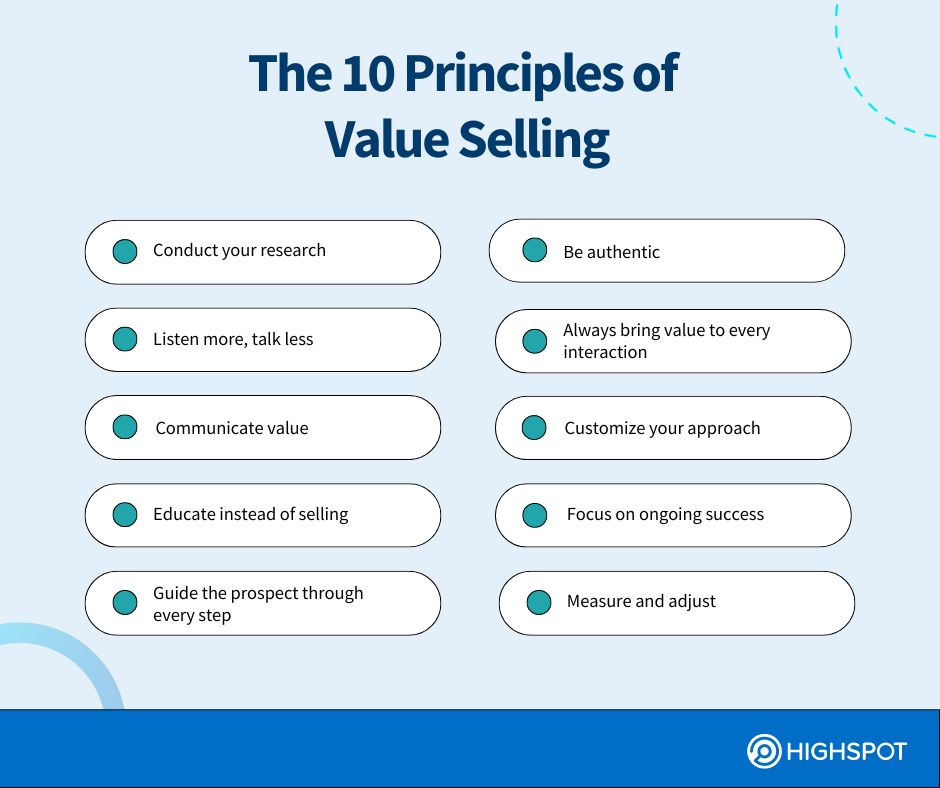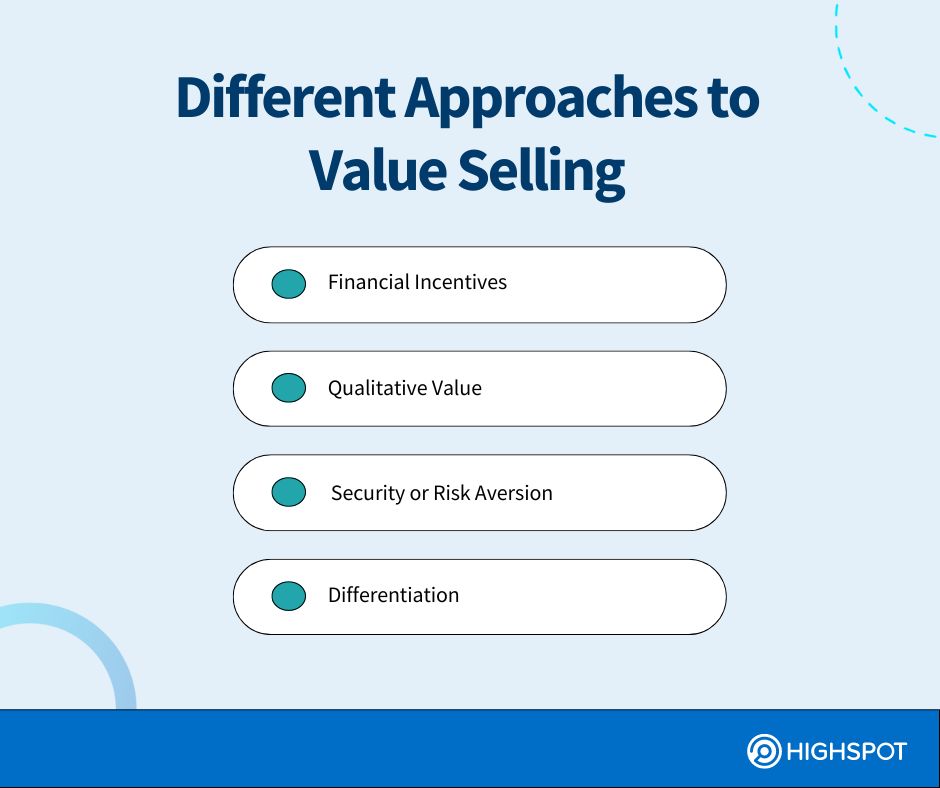Real value is created when a product or service’s benefits outweigh the cost. And offering value is the most important thing you can give your customers. Unfortunately, many B2B sales organizations are still too focused on their products, failing to help customers understand and realize this value.
To combat this, companies are increasingly adopting value-based selling strategies to meet their growth expectations. A staggering 87% of high-growth companies take a value-added approach to sales compared to only 45% of negative-growth companies. This shift highlights the importance of truly understanding and delivering customer value.
In this guide, you will find ten key principles to succeed at value selling and tips for finding the value that matters most to each prospective customer.
What Is Value Selling?
Value selling focuses on helping prospects recognize the unique value of your product. Sales reps highlight benefits rather than just focusing on features or price. This sales methodology changes the customer conversation from “What do you need?” to “What value can you bring to your business?”
The value-based selling approach guides sales reps to determine what potential customers care about and helps them realize that your product or service provides greater value than alternatives. By quantifying the benefits and making a convincing case, value-based selling becomes particularly effective in competitive markets where prospects seek clear, tangible reasons to select one product or service over another.
Why Is Value Selling Important?
Today, prospective customers want more than just a product—they’re looking for relationships and real benefits beyond a simple purchase.
Successful sales teams recognize that building a value-based partnership is much more effective than just making a sale. Just ask reps responsible for cross-sell and up-sell opportunities where long-term customer value is essential. Forrester defines customer value as “a customer’s perception of what they get versus what they give up in the pursuit of a goal.” This balance ensures prospects see tangible benefits from their purchases.
Achieving this requires aligning customer-facing roles with customer-centric value. This is evident in organizations with high levels of alignment across their customer-facing functions. According to a Forrester survey, these organizations reported 2.4 times higher revenue growth and twice the profitability growth of those with no alignment.
Let’s look at the are the top four benefits of adopting a customer-obsessed, value-based sales approach:
- Builds stronger relationships: Value-based selling promotes trust and long-term relationships. Customers are likely to remain loyal when they experience your investment in delivering business value, and they may even refer others.
- Differentiate your offerings: Finding unique ways to stand out is a must in today’s crowded market. Value-based selling requires a keen knowledge of competitive offerings so that sales reps can emphasize your product’s unique benefits. This approach helps customers understand their choice and why they should choose your product over competitors.
- Increases customer satisfaction: Because value-based selling is customer-centric and often promotes this same hyper-focus on customer success across the organization, customer satisfaction tends to be much higher. The good news is that satisfied customers are more likely to provide positive reviews and repeat business.
- Boosts sales efficiency: When sales teams prioritize their impact on customers, they seek leads that fit their product. This focus results in shorter sales cycles and higher conversion rates.
The 10 Principles of Value Selling
It’s no secret that customers who trust your team and your product stick around for the long term. So, how do your sales reps perfect value selling? They start with understanding their customers, honing their listening and communication skills, and mastering other techniques with the help of a robust sales training platform.
Here’s a closer look at the ten fundamentals that can help your sales team succeed with value selling:

1. Conduct Your Research
It’s impossible to help customers recognize value without knowing what they value. This means doing your homework before any sales call. Researching your prospect enables you to understand their company, industry, background, and current pain points, preparing you for a more meaningful conversation. Key areas to research include:
- The prospect’s role and experience: Understand their position within the company hierarchy and their specific responsibilities. Knowing whether they are a decision-maker, influencer, or end-user helps tailor your conversation to address their specific needs and concerns.
- Common connections: Identify mutual contacts or colleagues who can provide insights or introductions. Leveraging these connections can build trust and rapport more quickly. Mentioning a shared connection in your initial outreach can also increase your chances of getting a positive response.
- LinkedIn and other social media activity: Pay attention to the content they share, comment on, or engage with. This can give you a sense of their current priorities and challenges. Use this information to personalize your approach and make your conversation more relevant to their interests.
- Company information: Gather details about the company’s history, industry challenges, and recent developments. Familiarize yourself with their company size, products or services, and top competitors.
- Any previous interactions recorded in your CRM: Review any past communications or interactions to tailor your approach and build on previous conversations. Highlight any issues or questions raised to show continuity and commitment to addressing their concerns.
2. Listen More, Talk Less
It can be tempting to jump straight into your sales pitch, especially if you already did your research about the prospect. However, you should always let them speak about their current situation and needs first.
It may take longer to close the deal, but this will help build trust and give you essential information to tailor your solution’s value to what resonates most with them. This increases the chances for sales success.
3. Communicate Value
To help your prospect understand why your product is the right solution, clearly articulate its benefits. Ensure these benefits are relevant to their specific needs and challenges. Use case studies, testimonials, and data to support your claims.
Let’s look at a value selling example. Imagine you’re offering project management software, and your prospect is dealing with patchwork systems that cause their teams to struggle with fragmented communication, missed deadlines, and lack of accurate data.
- Can your tool facilitate real-time updates, file sharing, and collaborative workspaces?
- Value: Better productivity, visibility, and communication.
- Can it automate repetitive tasks like task assignments and notifications?
- Value: Teams can focus on high-value activities, increasing project completion rates and reducing errors.
- Can it integrate with other essential tools, like CRM?
- Value: Streamlined business processes, more cost savings, and enhanced scalability.
- Can it generate detailed, real-time reports to gain insights into project performance?
- Value: Improved data accuracy, mitigated risk, and better decision-making.
The key is to break their problem into smaller parts and match these to the product features that address them. From there, you can determine the best value proposition.
4. Educate Instead of Selling
When you establish yourself as an industry expert buyers turn to for advice, you become the first person they think of when they are ready to make a decision. The good news is that there are many ways to become a trusted advisor.
For one, you can share guides, blogs, and analyst research—including Gartner, Forrester, and IDC—to help prospects understand their challenges and the solutions available. Telling success stories of past clients who faced similar struggles can also boost your prospect’s confidence in their decision to choose your product or service.
5. Guide the Prospect Through Every Step of the Buying Process
Even though value selling is not the same as consultative selling, it’s important to consult and guide prospects through the buying process. Instead of jumping ahead and explaining value they might not grasp, especially if they aren’t fully aware of their problem yet, you should focus on the challenges they mention at the moment and tackle those head-on.
Customers will realize value at different phases, and sales reps must be ready to offer advice, real-life examples with potential outcomes, and data-based insights that help prospects make informed decisions.
6. Be Authentic
Maintain a conversational and genuine tone in your interactions. Show sincere interest in your prospect’s business and avoid using overly sales-y language. Ask open-ended questions, engage in meaningful conversations, and communicate as if offering advice to a friend.
Even if small talk isn’t your favorite, it can go a long way in building rapport. You can start the conversation with simple topics like upcoming trips they’re planning or interesting projects they’ve recently worked on.
7. Always Bring Value in Every Interaction
Always aim to make your prospect’s experience positive and helpful. You can do this by actively listening without interrupting, helping them think about something in a new way, giving them enough time for questions, and showing respect for their answers and opinions. These small yet thoughtful gestures show you’re invested in their success.
8. Customize Your Approach
No two buyers are the same, which is why you should tailor your pitch to each prospect based on their unique needs and challenges. Consider different value dimensions, such as risk mitigation, qualitative benefits, and financial incentives, and adapt your approach to highlight the most relevant value of your solution.
Related Resource: The Modern Sales Pitch – 5 Best Practices to Engage the Modern Buyer
9. Focus on Ongoing Success
Value-based selling doesn’t end with the sale. Commit to supporting your customers’ long-term success by providing ongoing assistance and resources. When customers trust your sales team to solve their problems, they are likely to choose your solutions again.
Regular follow-ups, training sessions, and updates demonstrate your dedication to their continued satisfaction, helping build lasting relationships and potential add-on revenue.
10. Measure and Adjust
Sales leaders can track engagement levels, customer satisfaction scores, sales performance metrics, and retention rates to measure the impact of value selling. Use this data to identify areas for improvement and adjust your approach.
On top of that, conduct regular reviews of won and lost deals to understand why customers chose your solution or went with a competitor. This analysis helps pinpoint the strengths and weaknesses of your sales strategy.
Approaches to Value-Based Selling
The key to value-based sales success is identifying what resonates emotionally with each prospect. Understanding and addressing these unique priorities early in the sales process makes engagement easier.

Financial Incentives
Businesses constantly look to improve their bottom line, so showing how your product can save money or generate revenue is highly effective. Provide concrete data, such as case studies and ROI analyses, to illustrate the financial benefits.
Explain how your solution can reduce costs, increase efficiency, or drive sales growth. By presenting clear, quantifiable economic benefits, you can create a strong value proposition that appeals directly to your prospect’s financial interests.
If you are selling an HVAC system, for instance, you can speak about how not only your units can reduce monthly utility bills by 30% but also pay for themselves within two years through lowered maintenance costs and improved operational efficiency.
Qualitative Value
A qualitative approach to value-based selling emphasizes the intangible benefits your product or service can offer. Instead of relying on hard numbers, focus on the personal level. How will your solution improve the day-to-day experiences of your customers?
Be sure to identify your prospect’s pain points and inefficiencies and explain how your offering can alleviate these issues. For example, you may want to highlight that your product can simplify user experience and streamline workflows for teams.
Security or Risk Aversion
Addressing your prospects’ specific fears and vulnerabilities will provide them peace of mind. This emphasizes the importance of a roadmap with solutions that enhance security without increasing risk.
Show how your solution can mitigate risks and improve security. Describe how your product has helped other companies avoid risks or navigate challenging situations. Let’s say you’re offering a cloud storage solution—you can show its advanced encryption features, ensuring data remains safe from unauthorized access and compliant with industry regulations.
Differentiation
Differentiating your solution involves highlighting its unique features, superior performance, or exceptional customer service. Find out what makes your prospect unique and align your solution and messaging with their industry and initiatives.
Explain how your product can enhance their brand’s distinctive qualities and help them achieve their objectives. For instance, if you’re providing a packaging solution for food products, you can emphasize that it’s made from 100% biodegradable materials derived from plant-based sources. This distinguishes your client as a forward-thinking and environmentally conscious brand.
How Does Value Selling Compare to Other Methodologies?
Many selling frameworks overlap and can complement each other, but each has nuances. Understanding these distinctions helps sales teams choose the methodologies that meet their unique industry and customer needs.
- Solution Selling: While value-based selling centers on the value and benefits to meet the prospect’s needs, solution selling focuses on addressing their major pain points with a comprehensive solution. It may involve integrating multiple products or services to resolve the customer’s problems.
- Challenger Selling: Challenger selling is about teaching, tailoring, and taking control of the sales conversation. Sales professionals challenge the customer’s thinking and provide new perspectives that can shape their buying decisions. While both Challenger and value selling focus heavily on customer engagement, the latter focuses on aligning the solution with what the customer values most.
- SNAP Selling: Unlike value selling, which involves a long sales cycle, SNAP selling is all about speeding up the sales process by keeping things Simple, iNvaluable, Aligning with customer needs, and Prioritizing based on their processes. It makes decision-making more manageable for customers by cutting through complexity and focusing on what really matters.
Let Highspot Help You Boost Value-Driven Sales
Buyers expect sales professionals to solve their challenges, not just sell them products. Traditional sales techniques often fall short, which is why companies are embracing value selling. This approach helps sales reps become trusted advisors, focusing on customer-centric interactions.
Highspot integrates the value selling framework into its sales training software, equipping your sales team to deliver value at every step to close deals.
Ready to elevate your sales strategy? Request a Highspot demo today.




